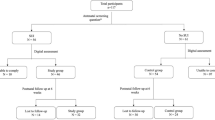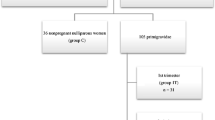Abstract
The aim of the study was to measure pelvic floor muscle function in continent and incontinent nulliparous pregnant women. The study group consisted of 103 nulliparous pregnant women at 20 weeks of pregnancy. Women reporting urinary incontinence once per week or more during the previous month were classified as incontinent. Function was measured by vaginal squeeze pressure (muscle strength) and increment in thickness of the superficial pelvic floor muscles (urogenital diaphragm) assessed by perineal ultrasound. Seventy-one women were classified as continent and 32 women as incontinent. Continent women had statistically significantly higher maximal vaginal squeeze pressure and increment in muscle thickness when compared with incontinent women. There was a strong correlation between measurements of vaginal squeeze pressure and perineal ultrasound measurements of increment in muscle thickness. This study demonstrates statistically significant differences in pelvic floor muscle function measured by strength and thickness in continent compared with incontinent nulliparous pregnant women.




Similar content being viewed by others
References
Viktrup L, Lose G, Rolf M, Barfoed K (1993) The frequency of urinary symptoms during pregnancy and puerperium in the primipara. Int Urogynecol J 4:27–30
Burgio KL, Locher JL, Zyczynski H, Hardin JM, Singh K (1996) Urinary incontinence during pregnancy in a racially mixed sample: characteristics and predisposing factors. Int Urogynecol J 7:69–70
Mørkved S, Bø K (1999) Prevalence of urinary incontinence during pregnancy and postpartum. Int Urogyn J 10:394–398
Viktrup L (2002) The risk of lower urinary tract symptoms five years after the first delivery. Neurourol Urodyn 21:2–29
De Lancey JOL (1996) Stress urinary incontinence: where are we now, where should we go? Am J Obstet Gynecol 175:311–319
DeLancey JOL (1988) Structural aspects of the extrinsic continence mechanism. Obstet Gynecol 72:296–300
Koelbl H, Strassegger H, Riss PA, Gruber H (1989) Morphologic and functional aspects of pelvic floor muscles in patients with pelvic relaxation and genuine stress incontinence. Obstet Gynecol 74:789–795
Sultan AH, Kamm MA, Bartram CI, Hudson CN (1994) Perineal damage at delivery. Contemp Rev Obstet Gynaecol 6:18–24
Peschers UM, Gingelmaier A, Jundt K, Leib B, Dimpfl T (2001) Evaluation of pelvic floor muscle strength using four different techniques. Int Urogynecol J 12:27–30
Hahn I, Milsom I, Ohlsson BL, Ekelund P, Uhlemann C, Fall M (1993) Pelvic floor training for genuine stress urinary incontinence. Evaluation and long-term results (dissertation). The University of Gothenburg, Gothenburg, Sweden
Petri E, Koelbl H, Schaer G (1999) What is the place of ultrasound in urogynecology? A written panel. Int Urogynecol J 10:262–273
Kohorn EI, Sciosa AL, Jeanty P (1986) Ultrasound cystourethrography by perineal scanning for the assessment of female stress urinary incontinence. Obstet Gynecol 68:269–272
Schaer GN, Koechli B, Schuessler B, Haller U (1995) Perineal ultrasound for evaluating the bladder neck in urinary stress incontinence. Obstet Gynecol 85:220–224
Peschers UM, Schaer G, DeLancey JOL, Schuessler B (1997) Levator function before and after childbirth. Br J Obstet Gynaecol 104:1004–1008
Meyer S, Bachelard O, DeGrandi (1998) Do bladder neck mobility and urethral sphincter function differ during pregnancy compared with during the non-pregnant state? Int Urogynecol J 9:397–404
Dietz HP, Wilson PH, Clarke B (2001) The use of perineal ultrasound to quantify levator activity and teach pelvic floor muscle exercises. Int Urogynecol J 12:166–169
Wisser J, Schaer G, Kurmanavicius J, Huch R, Huch A (1999) New approach to assess obstetrical trauma to the pelvic floor with 3-D ultrasound. Ultraschall Med 20:15–18
Ochsenbein N, Kurmanavicius J, Huch R, Huch A, Wisser J (2001) Volume sonography of the pelvic floor in nulliparous women and after elective cesarean section. Acta Obstet Gynecol Scand 80:611–615
Bernstein IT (1997) The pelvic floor muscles: muscle thickness in healthy and urinary-incontinent women measured by perineal ultrasonography with reference to the effect of pelvic floor training. Estrogen receptor studies (dissertation). Neurourol Urodyn 16:237–275
Mørkved S, Bø K, Schei B, Salvesen KÅ (2003) Pelvic floor muscle training during pregnancy to prevent urinary incontinence—a single blind randomized controlled trial. Obstetrics & Gynecology 101:313–319
Kegel AH (1956) Stress incontinence of urine in women: physiological treatment. J Int Coll Surg 25:487–499
Bø K, Hagen RH, Kvarstein B, Larsen S (1990) Pelvic floor muscle exercise for the treatment of female stress urinary incontinence II. Validity of vaginal pressure measurements of pelvic floor muscle strength. The necessity of supplementary methods for control of correct contraction. Neurourol Urodyn 9:479–487
Nichols DH, Milley PS (1971) The relationship between the pubo-urethral ligaments and the urogenital diaphragm in the human female. Anat Rec 170:281
Oelrich TM (1983) The striated urogenital sphincter muscle in the female. The anatomical record 205:223–232
Tan IL, Stoker J, Zwamborn AW, Entius KAC, Calame JJ, Lameris JS (1998) Female pelvic floor: endovaginal MR imaging of normal anatomy. Radiology 206:777–783
Stoker J, Halligan S, Bartram CI (2001) Pelvic floor imaging. Radiology 218:621–641
Schaer GN, Koechli B, Schuessler B, Haller U (1996) Perineal ultrasound: determination of reliable examination procedures. Ultrasound Obstet Gynecol 7:347–352
Demirci F, Ozden S, Alpay Z, Demirci ET, Ayas S (2001) The effects of vaginal delivery and cesarean section on bladder neck mobility and stress urinary incontinence. Int Urogynecol J 12:129–133
Lagro-Janssen ALM, Debruyne FMJ, Van Weel C (1991) Value of patient’s case history in diagnosing urinary incontinence in general practice. Br J Urol 67:569–572
Clarke B (1997) The role of urodynamic assessment in the diagnosis of lower urinary tract disorders. Int Urogynecol J 8:196–200
Cundiff G, Harris RL, Coates KW, Bump RC (1997) Clinical predictors of urinary incontinence in women. Am J Obstet Gynecol 177:262–267
DiNubile NA (1991) Strength training. Clin Sports Med 10:33–62
Komi PV (1992) Strength and power in sport. Blackwell scientific publications
Acknowledgements
We want to thank Nancy Lea Eik-Nes for the English revision of the manuscript. The work was founded by The Norwegian Fund for Postgraduate Training in Physiotherapy and Norwegian Women’s Public Health Association.
Author information
Authors and Affiliations
Corresponding author
Additional information
Editorial Comment: This study evaluated pelvic floor muscle function in 103 nulliparous continent and incontinent women at 18–20 weeks gestation. Pelvic floor muscle strength was assessed by measuring vaginal squeeze pressure, and thickness of the urogenital diaphragm during both relaxation and contraction was measured using perineal ultrasound. The authors found a statistically significant higher vaginal squeeze pressure and higher mean increment in muscle thickness in the continent compared with incontinent group as well as a strong correlation between pelvic floor muscle strength and increment in thickness. Although describing several benefits of ultrasonography in assessing pelvic floor muscles, the authors did acknowledge the difficulty in identifying and measuring these muscles, and the learning curve involved with perineal ultrasound. Another limitation was the subjective classification of continence status based on self-reported symptoms. The implication of low pelvic floor muscle strength and thickness as risk factors for the development of urinary incontinence is beyond the scope of this study.
Rights and permissions
About this article
Cite this article
Mørkved, S., Salvesen, K.Å., Bø, K. et al. Pelvic floor muscle strength and thickness in continent and incontinent nulliparous pregnant women. Int Urogynecol J 15, 384–390 (2004). https://doi.org/10.1007/s00192-004-1194-0
Received:
Accepted:
Published:
Issue Date:
DOI: https://doi.org/10.1007/s00192-004-1194-0




